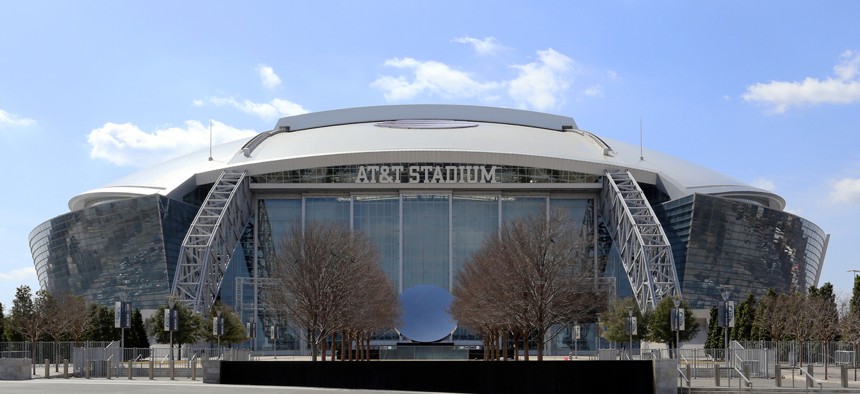Thinking Beyond Taxpayer Dollars for Stadium Improvements

Venues like AT&T stadium will have to rely less on local financing in the future for stadium improvements. Katherine Welles | SHUTTERSTOCK
COMMENTARY | Municipalities are now significantly less likely to spend public dollars on new stadium development. Owners and public officials are finding different, mutually beneficial partnerships to generate revenue for stadium upgrades.
AT&T Stadium was the talk of the sports world in 2009 when the Dallas Cowboys moved in. From the massive, midfield HD scoreboard to the field-level club boxes to the open-air party decks, the new facility offered a gameday experience like no other.
But so-called “Jerry World”—as the stadium is sometimes called after Cowboys owner Jerry Jones—has been open for more than a decade and rather than usher in a new age of ultra-luxury stadiums it has remained one of a handful of examples of taxpayer-subsidized facilities. In the last several years, the appetite to take on costly projects like the $1.15 billion stadium in Arlington, Texas—$325 million of which was paid by tax revenue approved by local voters—has mostly dried up.
A Long History of Public Financing
Public financing for stadiums and arenas dates back to the early 1800s. Since then, state and municipal governments have used a variety of measures to help finance stadium construction, including bonds, sales taxes, sin taxes and hotel taxes. From 1991-2010, 101 new stadiums were opened across the country and most had some taxpayer funding.
But the Great Recession that began in 2008 accelerated questions about the value of publicly financed stadiums and the associated tax burden on local communities, resulting in a rapid decline in taxpayer-supported stadium construction.
Teams will still sometimes threaten that without new or improved stadiums, they’ll find new homes. While voters don’t want teams to leave, they also don’t want their taxes to pay for facility improvements.
This scenario has most recently played out in Oakland and San Diego. Both California cities resisted public financing for football stadiums. In the case of the Oakland Raiders, the team did find a city willing to build a new stadium. The Raiders are expected to move into a facility—partially publicly financed through $750 million in tourist taxes—in Las Vegas later this year. But the Chargers have moved to Los Angeles, where the team will share a massive, $5 billion privately funded stadium with the Rams in Inglewood. That project, which is also expected to be ready later this year, could eventually end up benefiting from as much as $100 million in local tax breaks.
Ultimately, when a team moves over a stadium fight both cities and teams suffer. The city loses an important cultural attraction and the teams are uprooted away from their devoted fan base.
A New Mindset
In the face of growing resistance from cities and states, more teams are getting creative in identifying revenue streams for future stadium development that also benefits the city.
One option that’s catching fire is real estate.
The sea of parking lots that surround many ballparks and stadiums have long been a lost opportunity. Between regular season games, playoff games, concerts and other events, stadiums are lucky if the parking lot gets used more than 100 days a year. But now they are being put to better use.
The Colorado Rockies negotiated with the Denver Metropolitan Major League Baseball Stadium District for the rights to develop a parking lot adjacent to the stadium. In return, the district will use the lease payments to fund the ballpark’s ongoing costs.
The Metropolitan Football Stadium District (MFSD), the Denver Broncos and the City and County of Denver have developed a master plan for the parking lots located to the south of the stadium over the next several years. The master plan highlights a variety of different projects, including potentially 3-4 million square feet of development featuring apartments, hotels, retail, restaurants and office space.
For MFSD, the plan would be a way to bring in much-needed, year-round revenue as capital to maintain the now 19-year-old Empower Field at Mile High. Simultaneously, it would help boost city tax revenue and bring vitality to an underutilized neighborhood.
Similarly, in California, LA Live is an entertainment district right next to the Staples Center that gives fans something to do before NBA games and operates as a year-round venue. The Philadelphia 76ers, New England Patriots, Atlanta Braves and others have done the same.
The days of relying on taxpayers for stadium construction are almost over. Moving forward, owners should think about how best to leverage their assets similar to Los Angeles and Denver to bring in revenue and also keep cooperation with city officials alive while serving a larger public good.
Craig Umbaugh is a Partner in Hogan Lovells’ Sports and Entertainment Group.
NEXT STORY: Deep Dive Into State Budgeting Practices Finds Improvements





